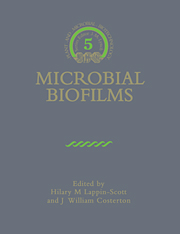Book contents
- Frontmatter
- Contents
- List of Contributors
- Series Preface
- Introduction to Microbial Biofilms
- Part I Structure, Physiology and Ecology of Biofilms
- Part II Biofilms and Inert Surfaces
- 7 Biofilm Development in Purified Water Systems
- 8 Mineralized Bacterial Biofilms in Sulphide Tailings and in Acid Mine Drainage Systems
- 9 Biofilms and Microbially Influenced Corrosion
- 10 Microbial Consortia in Industrial Wastewater Treatment
- 11 Heterogeneous Mosiac Biofilm – A Haven for Waterborne Pathogens
- Part III Biofilms on the Surfaces of Living Cells
- Index
9 - Biofilms and Microbially Influenced Corrosion
Published online by Cambridge University Press: 24 November 2009
- Frontmatter
- Contents
- List of Contributors
- Series Preface
- Introduction to Microbial Biofilms
- Part I Structure, Physiology and Ecology of Biofilms
- Part II Biofilms and Inert Surfaces
- 7 Biofilm Development in Purified Water Systems
- 8 Mineralized Bacterial Biofilms in Sulphide Tailings and in Acid Mine Drainage Systems
- 9 Biofilms and Microbially Influenced Corrosion
- 10 Microbial Consortia in Industrial Wastewater Treatment
- 11 Heterogeneous Mosiac Biofilm – A Haven for Waterborne Pathogens
- Part III Biofilms on the Surfaces of Living Cells
- Index
Summary
Introduction
Biofilms possess a number of distinctive characteristics that both define their inherent interest as biological systems worthy of study, and determine their very considerable practical importance in a wide range of environmental, industrial and medical processes. For example, in most natural ecosystems they are comprised not of individual organisms growing in axenic culture, but rather of mixed communities of species with differing but complementary metabolic capabilities. Such consortia demonstrate structural as well as functional organization giving rise to localized microenvironments, each with a particular combination of organisms and physicochemical conditions. The ubiquity of bacterial biofilms extends to their normal association with metal substrata in such situations as ships' hulls and marine structures, water and petroleum transmission lines, and a wide range of process equipment.
In biocorrosion, biofilms are of central importance to the processes involved, with the following individual features of their structure and function assuming particular significance. (i) The substratum on which the biofilm is built may also become a substrate in respect of acting as a source of metabolic energy (H2 oxidation). (ii) Heterogeneities in the horizontal dimension (colonial growth or patchiness) can establish localized electrochemical corrosion cells through the creation of oxygen concentration or differential aeration cells. (iii) The most significant vertical heterogeneity arises from the development of anaerobic regions at the base of the biofilm which can support the growth of sulphate reducing bacteria (SRB). (iv) The extracellular-polymeric substances, which constitute the main mass of the biofilm and underpin the maintenance of these heterogeneities and microenvironments, can also influence corrosion more directly by metal binding and/or retention of corrosion products.
- Type
- Chapter
- Information
- Microbial Biofilms , pp. 171 - 182Publisher: Cambridge University PressPrint publication year: 1995
- 8
- Cited by



